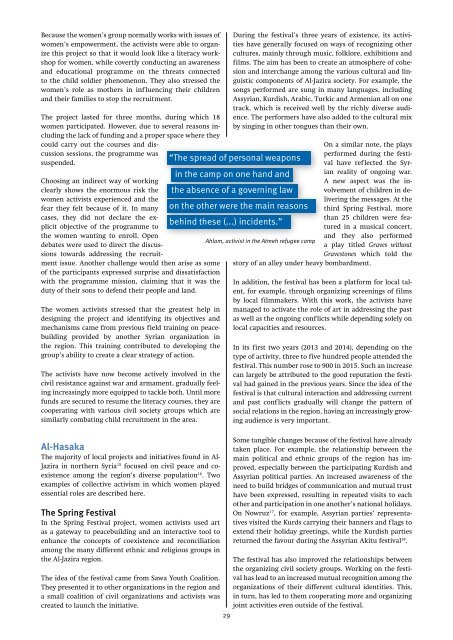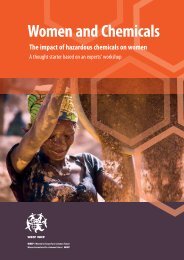future now”
YAO19
YAO19
You also want an ePaper? Increase the reach of your titles
YUMPU automatically turns print PDFs into web optimized ePapers that Google loves.
Because the women’s group normally works with issues of<br />
women’s empowerment, the activists were able to organize<br />
this project so that it would look like a literacy workshop<br />
for women, while covertly conducting an awareness<br />
and educational programme on the threats connected<br />
to the child soldier phenomenon. They also stressed the<br />
women’s role as mothers in influencing their children<br />
and their families to stop the recruitment.<br />
The project lasted for three months, during which 18<br />
women participated. However, due to several reasons including<br />
the lack of funding and a proper space where they<br />
could carry out the courses and discussion<br />
sessions, the programme was<br />
suspended.<br />
Choosing an indirect way of working<br />
clearly shows the enormous risk the<br />
women activists experienced and the<br />
fear they felt because of it. In many<br />
cases, they did not declare the explicit<br />
objective of the programme to<br />
the women wanting to enroll. Open<br />
debates were used to direct the discussions<br />
towards addressing the recruitment<br />
issue. Another challenge would then arise as some<br />
of the participants expressed surprise and dissatisfaction<br />
with the programme mission, claiming that it was the<br />
duty of their sons to defend their people and land.<br />
The women activists stressed that the greatest help in<br />
designing the project and identifying its objectives and<br />
mechanisms came from previous field training on peacebuilding<br />
provided by another Syrian organization in<br />
the region. This training contributed to developing the<br />
group’s ability to create a clear strategy of action.<br />
The activists have now become actively involved in the<br />
civil resistance against war and armament, gradually feeling<br />
increasingly more equipped to tackle both. Until more<br />
funds are secured to resume the literacy courses, they are<br />
cooperating with various civil society groups which are<br />
similarly combating child recruitment in the area.<br />
Al-Hasaka<br />
The majority of local projects and initiatives found in Al-<br />
Jazira in northern Syria 15 focused on civil peace and coexistence<br />
among the region’s diverse population 16 . Two<br />
examples of collective activism in which women played<br />
essential roles are described here.<br />
The Spring Festival<br />
In the Spring Festival project, women activists used art<br />
as a gateway to peacebuilding and an interactive tool to<br />
enhance the concepts of coexistence and reconciliation<br />
among the many different ethnic and religious groups in<br />
the Al-Jazira region.<br />
The idea of the festival came from Sawa Youth Coalition.<br />
They presented it to other organizations in the region and<br />
a small coalition of civil organizations and activists was<br />
created to launch the initiative.<br />
29<br />
During the festival’s three years of existence, its activities<br />
have generally focused on ways of recognizing other<br />
cultures, mainly through music, folklore, exhibitions and<br />
films. The aim has been to create an atmosphere of cohesion<br />
and interchange among the various cultural and linguistic<br />
components of Al-Jazira society. For example, the<br />
songs performed are sung in many languages, including<br />
Assyrian, Kurdish, Arabic, Turkic and Armenian all on one<br />
track, which is received well by the richly diverse audience.<br />
The performers have also added to the cultural mix<br />
by singing in other tongues than their own.<br />
On a similar note, the plays<br />
performed during the festival<br />
have reflected the Syrian<br />
reality of ongoing war.<br />
A new aspect was the involvement<br />
of children in delivering<br />
the messages. At the<br />
third Spring Festival, more<br />
than 25 children were featured<br />
in a musical concert,<br />
and they also performed<br />
a play titled Graves without<br />
Gravestones which told the<br />
story of an alley under heavy bombardment.<br />
“The spread of personal weapons<br />
in the camp on one hand and<br />
the absence of a governing law<br />
on the other were the main reasons<br />
behind these (...) incidents.”<br />
Ahlam, activist in the Atmeh refugee camp<br />
In addition, the festival has been a platform for local talent,<br />
for example, through organizing screenings of films<br />
by local filmmakers. With this work, the activists have<br />
managed to activate the role of art in addressing the past<br />
as well as the ongoing conflicts while depending solely on<br />
local capacities and resources.<br />
In its first two years (2013 and 2014), depending on the<br />
type of activity, three to five hundred people attended the<br />
festival. This number rose to 900 in 2015. Such an increase<br />
can largely be attributed to the good reputation the festival<br />
had gained in the previous years. Since the idea of the<br />
festival is that cultural interaction and addressing current<br />
and past conflicts gradually will change the pattern of<br />
social relations in the region, having an increasingly growing<br />
audience is very important.<br />
Some tangible changes because of the festival have already<br />
taken place. For example, the relationship between the<br />
main political and ethnic groups of the region has improved,<br />
especially between the participating Kurdish and<br />
Assyrian political parties. An increased awareness of the<br />
need to build bridges of communication and mutual trust<br />
have been expressed, resulting in repeated visits to each<br />
other and participation in one another’s national holidays.<br />
On Nowruz 17 , for example, Assyrian parties’ representatives<br />
visited the Kurds carrying their banners and flags to<br />
extend their holiday greetings, while the Kurdish parties<br />
returned the favour during the Assyrian Akitu festival 18 .<br />
The festival has also improved the relationships between<br />
the organizing civil society groups. Working on the festival<br />
has lead to an increased mutual recognition among the<br />
organizations of their different cultural identities. This,<br />
in turn, has led to them cooperating more and organizing<br />
joint activities even outside of the festival.



